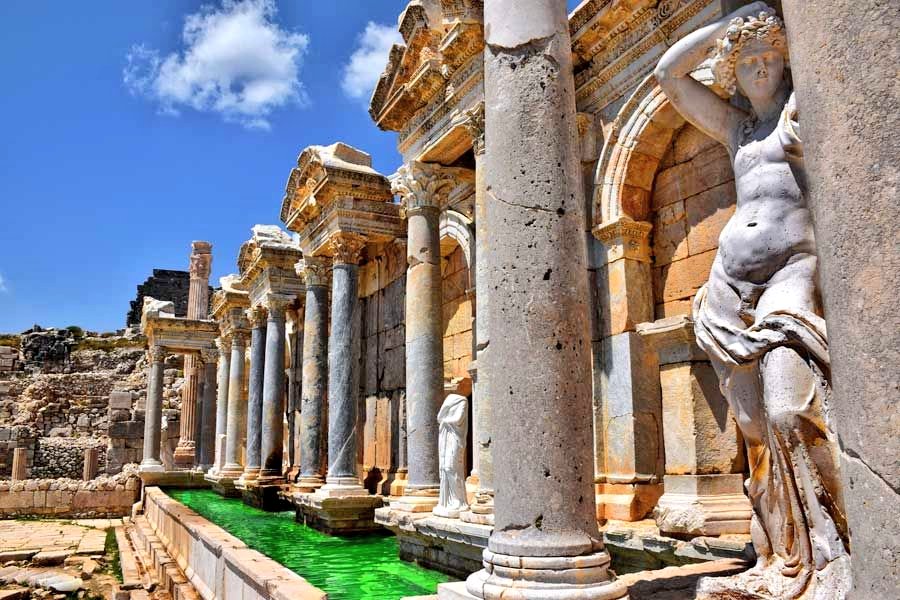Sagalassos is a city established at an altitude of 1500-1700 meters from the sea on the slopes of Akdağ and 7 km north of Ağlasun district of Burdur in Turkey.
Sagalassos is one of the most important cities of the Pisidia region during the Roman Imperial Period. Most of the buildings in the city belong to the Roman Period. The first discovery of Sagalassos by the Westerners was made by the French traveler Paul Lucas in 1706.
Just north of the entrance to the city, there is the courtyard and halls of a palace-sized city mansion. The large Roman Imperial Bath dominates the lower part of the city. The cold room, pools, warm and hot rooms of the monument are preserved. The lower floor of the bath opens onto the Lower Agora (square) of the city. Around the Lower Agora, there are the agora fountain and the temple of Apollo Klarios and Hadrian’s Fountain ruins at the upper level. In the Upper City, many monuments around the Upper Agora were unearthed and restored. Here is the magnificent Antonine Fountain; Two monumental arches opening onto the square, high honorary columns at the four corners of the agora, the town hall, the city council building, the church and the Heroon known for its reliefs of dancing girls can be seen.
Heading east, you can see the city’s ancient library, the Hellenistic fountain still fed by the original spring water, and the ancient theater further on. You suddenly find yourself in the Roman period.
The people of Sagalassos are from the Pisidian peoples, a branch of the Luwian tribes living in Western and Southern Anatolia at the end of the 3rd millennium BC. Alexander the Great captured this city in 333 BC. The city is seen for the first time in written historical sources when Alexander the Great (333-334 BC) captured the city in the quarter of the 4th century BC. We see that Sagalassos came under the domination of Seleucid (Seleukos) and Attalid (Attalos), and in 25 BC, King Amyntas of Galatia joined the Roman Empire by Augustus.
The large-scale economic growth, which started when Hadrian chose Sagalassos as the official center of the Pisidian imperial cult in the 120s, continued for a century and initiated the development of construction. Two earthquakes at the beginning of the 6th and 7th centuries AD, and the plague epidemic and political turmoil in Anatolia in the middle of the 6th century brought the end of the city.
Until the 7th century, life in the city continued by shrinking and gaining a more rural character. Until the 11th century AD, life in Sagalassos continued as a small village settlement with the people who took shelter on the hill where the Antoninus Pius temple used to be. At the beginning of the 13th century AD, the life in the city came to an end when the Seljuks destroyed the last Byzantine military fortress settlement on the Iskender Hill of Sagalassos.



Its most prominent feature is the magnificent Antonine fountain. Antonines, which is one of the rare fountains still working today at an altitude of 1,750 meters, is the center of attention of tourists who come to visit the city. Fountain also contains a number of stories in mythology. According to rumors that those who drink the water of the fountain fall in love. I hope the story is true. Let those who have the opportunity come and drink the water of love. and of course this is one of the preferred places for filming and TV series shooting.
The city experienced its best period economically, politically and socially during the reign of Emperor Hadrian (2nd century AD). Sagalassos is one of the best preserved ancient cities of Anatolia and was included in the UNESCO World Heritage Tentative National List in 2009.
Excavations since 1989 were conducted by the University of Leuven, Belgium, on behalf of the Ministry of Culture and Tourism, until his retirement in 2013 by Prof. Dr. by Marc Waelkens, followed by Prof. Dr. It continued under the chairmanship of Jeroen Poblome.
As a result of excavations and restorations, many artifacts and monuments have emerged. The skeletons found in the excavations in 1999, DNA tests of the local people were found to be related, indicating that the Turks, Greeks and Armenians who came to Anatolia were also fused with the local people. The colossal statues of Emperor Hadrian and Emperor Marcus Aurelius, which were unearthed during the 2007-2008 excavations, amaze those who see them with their craftsmanship, which is rare in the world. These statue heads, legs and feet and many works from Sagalassos are exhibited in the Burdur Museum today.
